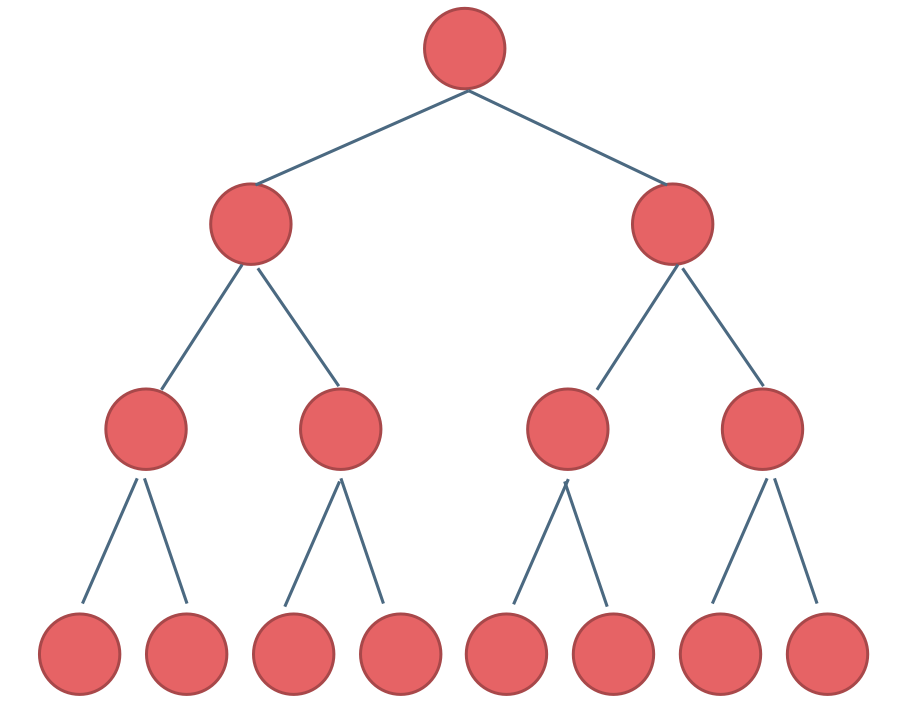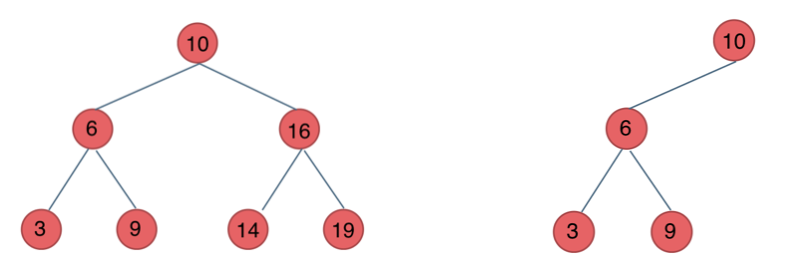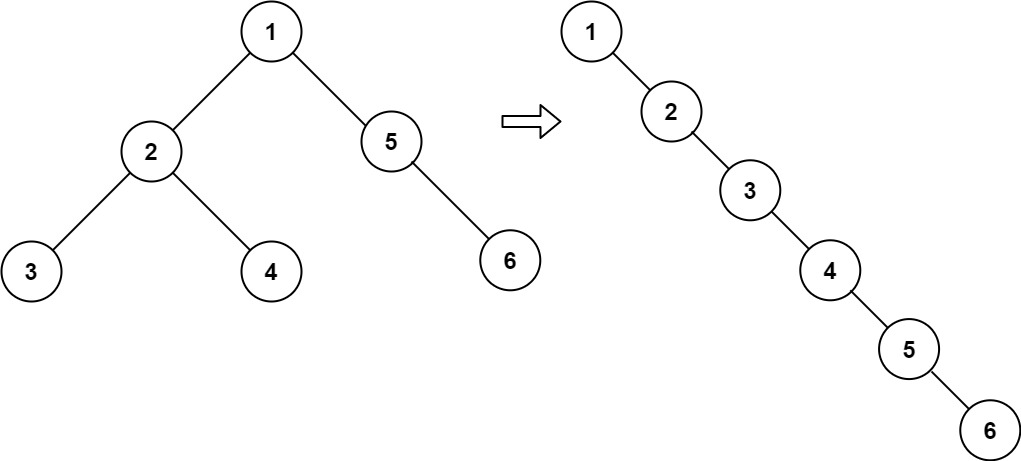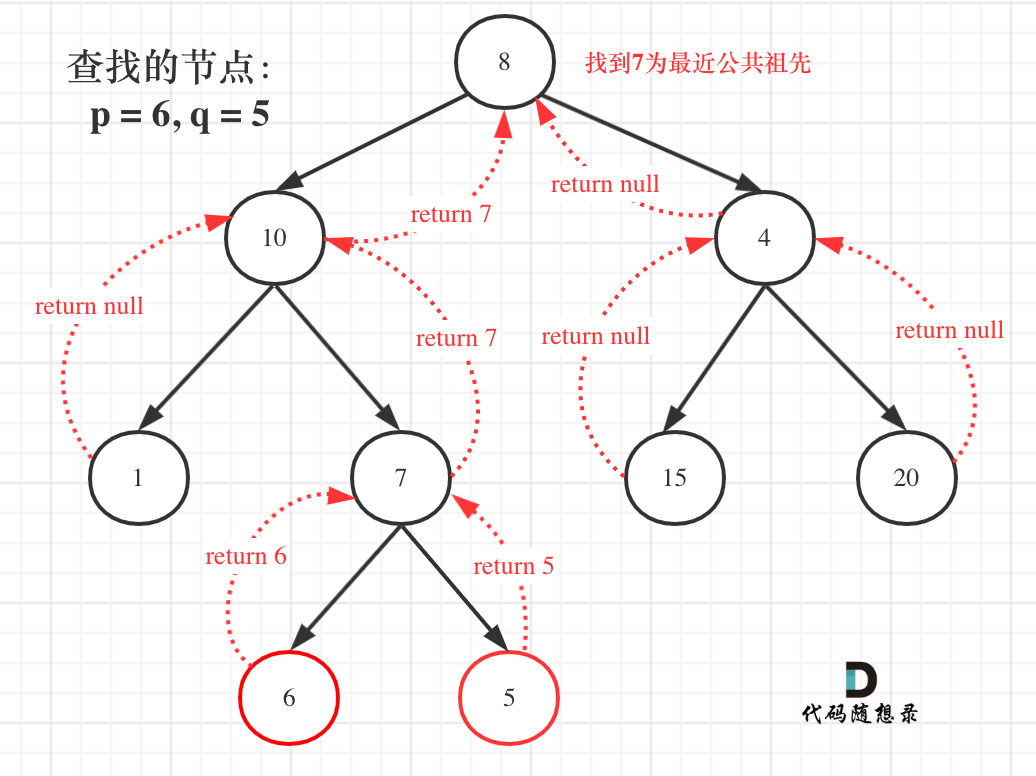如果一棵二叉树只有度为0的结点和度为2的结点,并且度为0的结点在同一层上,则这棵二叉树为满二叉树。

- 完全二叉树
在完全二叉树中,除了最底层节点可能没填满外,其余每层节点数都达到最大值,并且最下面一层的节点都集中在该层最左边的若干位置。若最底层为第 h 层,则该层包含 $1$~$2^{h-1}$ 个节点。

二叉搜索树是一棵有序树:
① 若它的左子树不空,则左子树上所有结点的值均小于它的根结点的值;
② 若它的右子树不空,则右子树上所有结点的值均大于它的根结点的值;
③ 它的左、右子树也分别为二叉排序树

它是一棵空树或它的左右两个子树的高度差的绝对值不超过1,并且左右两个子树都是一棵平衡二叉树。

二叉树是递归最经典的应用,是回溯、动态规划、分治的基础。基本上递归问题也都可以抽象为二叉树的问题。比如快速排序可以抽象为二叉树的前序遍历,归并排序可以抽象为二叉树的后序遍历。
二叉树主要有两种遍历方式:
前序遍历(递归法,迭代法)
中序遍历(递归法,迭代法)
后序遍历(递归法,迭代法)
层次遍历(迭代法)
写递归的思想在某些方面有点像数学归纳法,先假设一个方法能返回这个结果并相信这个方法,然后考虑最终的边界情况,之后将一个问题拆分为多个小的类似的问题递归解决。
写递归抓住三个要素:
-
确定递归函数的参数和返回值
-
确定终止条件
-
确定单层递归的逻辑
实际上递归的本质也是存在递归栈中,所以我们直接用栈就可以不需要递归,当然会比递归方法难写一些,用栈的迭代法可以节约空间降低复杂度。
二叉树的层次遍历也比较简单,需要利用队列这种数据结构。
代码框架如下:
1
2
3
4
5
6
7
8
9
10
11
12
13
14
15
16
17
18
19
20
21
22
23
24
25
26
|
func levelOrder(root *TreeNode) [][]int {
if root == nil {
return [][]int{}
}
var queue []TreeNode
queue = append(queue, *root)
var result [][]int
var row []int
for len(queue) != 0 {
length := len(queue)
for i := 0; i < length; i++ {
head := queue[0]
if head.Left != nil {
queue = append(queue, *head.Left)
}
if head.Right != nil {
queue = append(queue, *head.Right)
}
row = append(row, head.Val)
queue = queue[1:]
}
result = append(result, row)
row = []int{}
}
return result
}
|
递归法:
二叉树遍历的递归法写起来都很简单
1
2
3
4
5
6
7
8
9
10
11
12
13
14
|
func preorderTraversal(root *TreeNode) []int {
var result []int
pTraversal(root, &result)
return result
}
func pTraversal(cur *TreeNode, result *[]int) {
if cur == nil {
return
}
*result = append(*result, cur.Val)
pTraversal(cur.Left, result)
pTraversal(cur.Right, result)
}
|
迭代法,利用一个栈,注意是先放入右孩子再放入左孩子,这样出栈才是正确的顺序,前序遍历的迭代法也不难。
1
2
3
4
5
6
7
8
9
10
11
12
13
14
15
16
17
18
19
20
|
func preorderTraversal(root *TreeNode) []int {
var st []*TreeNode
var result []int
if root == nil {
return result
}
st = append(st, root)
for len(st) > 0 {
cur := st[len(st)-1]
result = append(result, cur.Val)
st = st[:len(st)-1]
if cur.Right != nil {
st = append(st, cur.Right)
}
if cur.Left != nil {
st = append(st, cur.Left)
}
}
return result
}
|
迭代法
这里迭代和前序遍历很不一样,首先需要记录之前的节点是否被遍历过,可以采用一个map,key是TreeNode指针,value是是否被遍历的bool值,也可以采用一个符合结构来记录这个TreeNode是够被遍历:
1
2
3
4
5
6
7
8
9
10
11
12
13
14
15
16
17
18
19
20
21
22
23
24
25
26
27
28
29
|
type MyTreeNode struct {
Node *TreeNode
Visited bool
}
func postorderTraversal(root *TreeNode) []int {
var st []*MyTreeNode
var result []int
if root == nil {
return result
}
st = append(st, &MyTreeNode{Node: root, Visited: false})
for len(st) > 0 {
cur := st[len(st)-1]
if cur.Visited || (cur.Node.Left == nil && cur.Node.Right == nil) {
result = append(result, cur.Node.Val)
st = st[:len(st)-1]
} else {
if cur.Node.Right != nil {
st = append(st, &MyTreeNode{Node: cur.Node.Right, Visited: false})
}
if cur.Node.Left != nil {
st = append(st, &MyTreeNode{Node: cur.Node.Left, Visited: false})
}
cur.Visited = true
}
}
return result
}
|
递归法
1
2
3
4
5
6
7
8
9
10
11
12
13
14
|
func inorderTraversal(root *TreeNode) []int {
var result []int
pTraversal(root, &result)
return result
}
func pTraversal(cur *TreeNode, result *[]int) {
if cur == nil {
return
}
pTraversal(cur.Left, result)
*result = append(*result, cur.Val)
pTraversal(cur.Right, result)
}
|
迭代法
和后序遍历很像,也是要额外的空间来存储各个节点是否被访问,这里唯一不同的就是需要先把自己取出来,然后把右子节点放进去再把自己放进去,这个时候visited置为true,再把左子节点放进去
1
2
3
4
5
6
7
8
9
10
11
12
13
14
15
16
17
18
19
20
21
22
23
24
25
26
27
28
29
30
31
32
|
type MyTreeNode struct {
Node *TreeNode
Visited bool
}
func inorderTraversal(root *TreeNode) []int {
var st []*MyTreeNode
var result []int
if root == nil {
return result
}
st = append(st, &MyTreeNode{Node: root, Visited: false})
for len(st) > 0 {
cur := st[len(st)-1]
if cur.Visited || (cur.Node.Left == nil && cur.Node.Right == nil) {
result = append(result, cur.Node.Val)
st = st[:len(st)-1]
} else {
// 先把自己取出来
st = st[:len(st)-1]
if cur.Node.Right != nil {
st = append(st, &MyTreeNode{Node: cur.Node.Right, Visited: false})
}
// 再把自己放回去
st = append(st, &MyTreeNode{Node: cur.Node, Visited: true})
if cur.Node.Left != nil {
st = append(st, &MyTreeNode{Node: cur.Node.Left, Visited: false})
}
}
}
return result
}
|

1
2
3
4
5
6
7
8
9
10
11
12
|
func invertTree(root *TreeNode) *TreeNode {
// 边界情况
if root == nil {
return root
}
// 当前操作
root.Left, root.Right = root.Right, root.Left
// 递归
invertTree(root.Left)
invertTree(root.Right)
return root
}
|

最先想到的方法是建立一个队列,层序遍历,但是代码量会比较复杂,一个非常好的方法是递归,但是不能直接套:
1
|
connect(root.Left, root.Right)
|
这样的话比如上图的5和6就连不起来,所以应该多考虑一个节点,代码如下:
1
2
3
4
5
6
7
8
9
10
11
12
13
14
15
16
17
|
func connect(root *Node) *Node {
if root == nil {
return root
}
connectTwoNodes(root.Left, root.Right)
return root
}
func connectTwoNodes(node1 *Node, node2 *Node) {
if node1 == nil || node2 == nil {
return
}
node1.Next = node2
connectTwoNodes(node1.Left, node1.Right)
connectTwoNodes(node1.Right, node2.Left)
connectTwoNodes(node2.Left, node2.Right)
}
|

首先相信flatten可以完成这个功能。然后分别套左右子树,然后root的Left断开,左子树的最后面接上右子树即可。当然因为这里要多一个左子树的循环走到底,浪费了时间,效率不高,但是容易理解。
1
2
3
4
5
6
7
8
9
10
11
12
13
14
15
16
17
18
|
func flatten(root *TreeNode) {
if root == nil {
return
}
flatten(root.Left)
flatten(root.Right)
l := root.Left
r := root.Right
if l == nil {
return
}
root.Left = nil
root.Right = l
for l.Right != nil {
l = l.Right
}
l.Right = r
}
|
二叉搜索树(Binary Search Tree,BST)有着广泛的应用,通过BST可以高效的搜索元素。
BST的性质:
- 任意一个节点的左子树所有节点的值都小于该节点,右子树所有节点的值都大于该节点
- 任意一个节点的左右子树都是BST
搜索模板是:
1
2
3
4
5
6
7
8
9
10
|
fun BSTSearch(TreeNode root, int target) {
if (root.val == target)
// 找到目标,做点什么
if (root.val < target){
BSTSearch(root.right, target)
}
if (root.val > target){
BSTSearch(root.left, target)
}
}
|
1
2
3
4
5
6
7
8
9
10
11
12
13
|
func searchBST(root *TreeNode, val int) *TreeNode {
if root == nil {
return nil
}
if root.Val == val {
return root
}
if root.Val < val {
return searchBST(root.Right, val)
} else {
return searchBST(root.Left, val)
}
}
|
二叉搜索树不能只看父节点和两个子节点的大小,而是整个左子树都小于,整个右子树都大于,所以单独开一个函数,多传入min和max两个参数。
1
2
3
4
5
6
7
8
9
10
11
12
13
|
func isValidBST(root *TreeNode) bool {
return valid(root, nil, nil)
}
func valid(root *TreeNode, min *int, max *int) bool {
if root == nil {
return true
}
if (max != nil && root.Val >= *max) || (min != nil && root.Val <= *min) {
return false
}
return valid(root.Left, min, &root.Val) && valid(root.Right, &root.Val, max)
}
|
1
2
3
4
5
6
7
8
9
10
11
12
13
14
|
func insertIntoBST(root *TreeNode, val int) *TreeNode {
if root == nil {
root = &TreeNode{Val: val, Left: nil, Right: nil}
return root
}
// 插入右子树
if root.Val < val {
root.Right = insertIntoBST(root.Right, val)
return root
} else {
root.Left = insertIntoBST(root.Left, val)
return root
}
}
|
1
2
3
4
5
6
7
8
9
10
11
12
13
14
15
16
17
18
19
20
21
22
23
24
25
26
27
28
29
|
func deleteNode(root *TreeNode, key int) *TreeNode {
if root == nil {
return nil
}
if root.Val == key {
if root.Left == nil && root.Right == nil {
return nil
} else if root.Left == nil {
root = root.Right
} else if root.Right == nil {
root = root.Left
} else {
// 获得左子树最大的节点
leftMax := root.Left
for leftMax.Right != nil {
leftMax = leftMax.Right
}
root.Left = deleteNode(root.Left, leftMax.Val)
leftMax.Left = root.Left
leftMax.Right = root.Right
root = leftMax
}
} else if root.Val > key {
root.Left = deleteNode(root.Left, key)
} else if root.Val < key {
root.Right = deleteNode(root.Right, key)
}
return root
}
|
1
2
3
4
5
6
7
8
9
10
11
12
13
14
15
16
17
|
func getMinimumDifference(root *TreeNode) int {
minDelta := math.MaxInt
traverse(root, &minDelta, &[]int{})
return minDelta
}
func traverse(root *TreeNode, min *int, result *[]int) {
if root == nil {
return
}
traverse(root.Left, min, result)
if len(*result) > 0 && root.Val-(*result)[len(*result)-1] < *min {
*min = root.Val - (*result)[len(*result)-1]
}
*result = append(*result, root.Val)
traverse(root.Right, min, result)
}
|
加一个Prev指针,利用二叉搜索树的性质,一次遍历即可
1
2
3
4
5
6
7
8
9
10
11
12
13
14
15
16
17
18
19
20
21
22
23
24
25
26
27
28
29
|
func findMode(root *TreeNode) []int {
var prev *TreeNode
result := make([]int, 0)
count, max := 1, 1
var traverse func(node *TreeNode)
traverse = func(node *TreeNode) {
if node == nil {
return
}
traverse(node.Left)
if prev != nil && prev.Val == node.Val {
count++
} else {
count = 1
}
if count >= max {
if count > max && len(result) > 0 {
result = []int{node.Val}
} else {
result = append(result, node.Val)
}
max = count
}
prev = node
traverse(node.Right)
}
traverse(root)
return result
}
|
本身代码量不多,但是思考稍微比较抽象。

1
2
3
4
5
6
7
8
9
10
11
12
13
14
15
16
17
18
19
20
|
func lowestCommonAncestor(root, p, q *TreeNode) *TreeNode {
if root == nil {
return nil
}
// 如果遇到p或者q,就直接返回
if root.Val == p.Val || root.Val == q.Val {
return root
}
left := lowestCommonAncestor(root.Left, p, q)
right := lowestCommonAncestor(root.Right, p, q)
// 如果左右都不是nil,也就是说明当前节点左边找到了一个,右边找到了一个,返回当前节点
if left != nil && right != nil {
return root
}
// 如果左边返回的不是nil,但是右边是nil,说明要从左边找
if left != nil {
return left
}
return right
}
|







